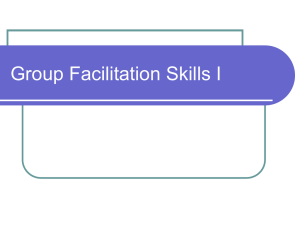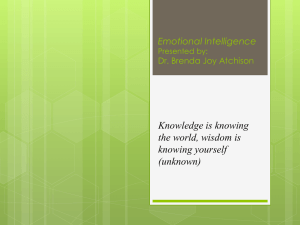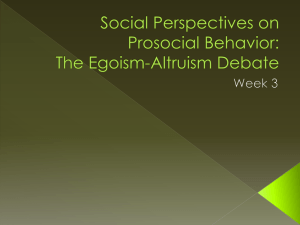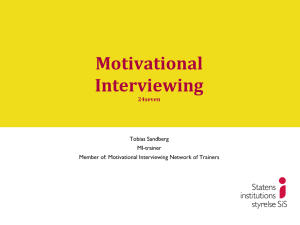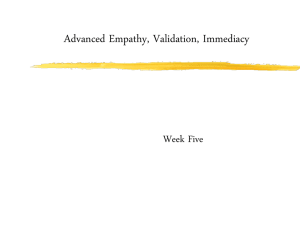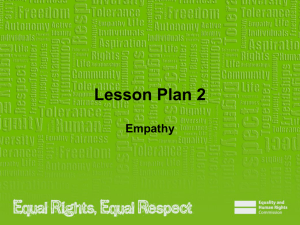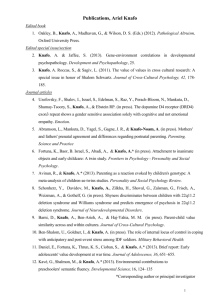Childhood Precursors of Depressive Symptoms and Disorders in
advertisement
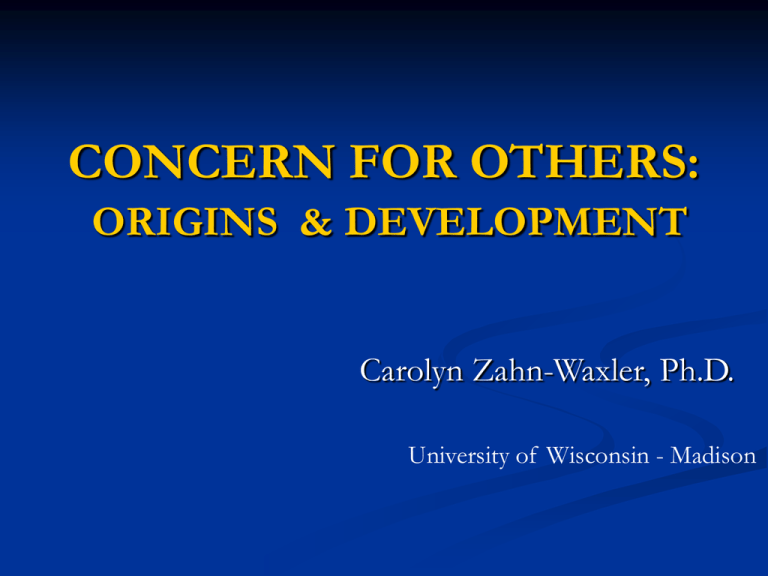
CONCERN FOR OTHERS: ORIGINS & DEVELOPMENT Carolyn Zahn-Waxler, Ph.D. University of Wisconsin - Madison THEORY OF MORAL SENTIMENTS: ADAM SMITH 1757 Morality is not always calculating Human beings are social creatures Born with natural empathy Concern for well-being of others is an essential feature of morality Empathy- understand other’s perspective & have a visceral or emotional response EARLY THEORIES: Children Lack Moral Sense before Age 7 Psychoanalytic Driven by sexual and aggressive impulses Cognitive Egocentric---immature Unaware cortex of others’ perspectives Sociobiological Human social nature is self-serving DIFFERENT VIEWS ‘LEGITIMIZE’ CONSTRUCT OF EMPATHY 1. Evolutionary altruism – E.O.Wilson emphasis on group process 2. Empathy in mammals – Paul MacLean distress cries of offspring > maternal caregiving limbic & prefrontal cortex – interconnections 3.Neuroscience –mirror neurons/emotional resonance wired to experience others emotions EMPATHY/CARING FOR OTHERS: CENTRAL ISSUES Biology Development Environment Nature and nurture interact Adaptive/Maladaptive CONCERN FOR OTHERS A. AFFECT ---Empathic Emotions; (face, voice, gesture) B. BEHAVIOR ---Prosocial Actions (helps, shares, comforts) C. COGNITION --- Effort to Understand (inquiries, ‘hypothesis-testing’) BIOLOGICAL ORIGINS OF EMPATHY Personal Distress Concern 0-12 mos 12-18 mos 18 + mos Personal Distress Concern ? 0-12 mos 12-18 mos 18 + mos LONGITUDINAL SAMPLES: 1-7 YRS A. CONCERN FOR OTHERS (normative) NIMH – singletons Colorado – twins Wisconsin- twins B. CONCERN FOR OTHERS (risk) Parental depression Marital conflict MULTIPLE METHODS: Home and Laboratory Mothers trained as observers Structured probes---simulated distress adults, peers, infants, animals ________________________________________ Maternal, teacher & child reports Natural observations in lab (sibs, peers) Mood inductions—physiological activity Narratives—children’s representations Natural distresses observed and caused by child JULIE, 18 mos A crying baby in a high chair threw away his cookies. Julie (1) tried to return his cookies. Mother then put baby in play pen and Julie hovered over him there. She began to (2) stroke his hair and (3) pat his shoulders making (4) sympathetic, cooing sounds. Next she went to (5) get her mother from another room. leading her to the play pen. Finally, she (6) took her mother’s hand and placed it on top of the baby’s head. She showed empathic concern throughout. NIMH: PROSOCIAL ACTS prosocial acts 0.5 0.4 Witness-real Simulated 0.3 0.2 0.1 0 13-15 18-20 23-25 months Zahn-Waxler et al. 1992 NIMH: EMPATHIC CONCERN empathic concern 0.3 0.25 0.2 Witnessed-real Simulated 0.15 0.1 0.05 0 13-15 18-20 23-25 months Zahn-Waxler et al. 1992 hypothesis testing NIMH: ‘HYPOTHESIS TESTING’ 0.3 0.25 0.2 Witnessed-real Simulated 0.15 0.1 0.05 0 13-15 18-20 23-25 months Zahn-Waxler et al. 1992 Development of Concern: Affective and Cognitive Forms Knafo, Zahn-Waxler, et al., 2008 3 2.8 2.6 Concern Hyp Test 2.4 2.2 2 14 months 20 months 24 months 36 months DEVELOPMENTAL REPLICATIONS Zahn-Waxler, et al. (2 samples) (1-2.5 yr olds) Knafo, et al., 2008 (twin sample)(1-3 yr. olds) Volbrecht, et al., 2007 (1.5-2 yr. olds) What about individual differences? Environment/parenting Temperament Genes Parenting Practices Empathy High Empathy High warmth Low control Low warmth High control 14 mos High warmth Low control Positive family climate Empathy Medium Empathy 20 mos Empathy 14 mos Low Empathy 20 mos Low warmth High control Negative family climate Low Control High Control 14 mos 20 mos Robinson et al. 1994 Child Temperament Empathy High Empathy High positivity, sociability, & negative affect 14 mos High positivity & sociability Empathy Medium Empathy 14 mos 20 mos Low positivity & sociability High positivity & sociability Empathy Low Empathy 20 mos Low positivity & sociability Low positivity & sociability 14 mos 20 mos Robinson et al. 1994 CARING GROWS FROM 1-2 YEARS Roth-Hanania, Davidov, & Zahn-Waxler, 2011 INFANTS’ CONCERN FOR OTHERS CHILDREN of DEPRESSED MOTHERS: 2-4 yr olds Prosocial to Mother 3 prosocial acts 2.5 2 Girls Boys 1.5 1 0.5 0 Well mothers Depressed mothers Zahn-Waxler & Radke-Yarrow responses to conflict CONCERN FOR OTHERS: Toddlers’ response to parent conflict 0.5 0.45 0.4 0.35 0.3 0.25 0.2 0.15 0.1 0.05 0 Anger Distress Prosocial Low Conflict High Conflict Cummings et al. CONCLUSIONS Empathy is present in first years of life Continuities/discontinuities across development Biological and environmental contributions to individual differences in children’s empathic concern and prosocial behavior Many ways in which concern for others may become compromised ---surfeits and deficits that interfere with the quality of children’s lives. New Directions Basic research Neural underpinnings in first year of life Developing literature on the social brain Interactions of parenting, genes, and epigenetic factors (Knafo, et al; Davidov, et al.) Early plasticity/malleability plus socialization lit. Opportune period of development for Interventions that incorporate positive socialization practices with mindfulness-based parenting COLLABORATORS Ronald Iannotti Carol Van Hulle Paul Hastings Michelle Volbrecht Soo Rhee Dale Hay Michael Chapman Robert King Hill Goldsmith Brett Haberstick Sharee Light Shari Young Pamela Cole Ronit Roth- Hanania Nathan Fox Mark Cummings Marian Radke-Yarrow Ariel Knafo Robert Emde JoAnn Robinson Barbara Usher Elizabeth Shirtcliff Maayan Davidov Thanks for Your Attention!

